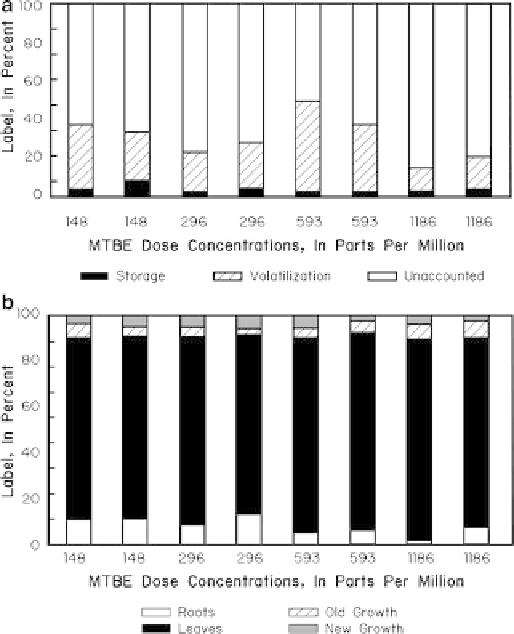Environmental Engineering Reference
In-Depth Information
Table 13.3
Reported physical and chemical properties of common
groundwater contaminants that have importance to plant bioavailability.
[TAME, tertiary-amyl methyl ether]
Contaminant Water solubility
(mg/L)
Log
K
ow
Log
K
oc
Henry's constant
(dimensionless,
H/RT
)
MTBE
>
50,000
1.2
1.04
0.018
10
4
TBA
infinitely
0.37
1.57
4.8
10
2
TAME
20,000
-
1.27
5.2
2.09
10
4
Ethanol
infinitely
-0.16 1.21
EDB
4,200
1.8
-
0.02
and was added to gasoline up to 15% by volume. However,
as an ether, it was very soluble in water (50,000 mg/L). Also,
USTs often leaked. It would turn out, by the end of the
twentieth century, that this answer to protect air quality
from degradation by gasoline engines had led, unexpectedly,
to groundwater-quality degradation.
Some of the common groundwater contaminants and
their physical and chemical properties related to plant uptake
are described in Table
13.3
. As this table indicates, the
similarity of MTBE with alcohols suggests that its relatively
low log
K
ow
and its relatively high solubility would render it
less likely for plant interaction than, say, BTEX.
Fig. 13.10
The variable fate of
14
C-MTBE added to cuttings grown
hydroponically (Modified from Hong et al. 2001).
13.4.1 Plant Interaction and Uptake Pathways
At the end of the 10-d experiment, the mass balance of the
14
C-MTBE added to the growth solution indicated that for
the 65% of
14
C-MTBE that was removed from the hydro-
ponic solution, about 27% was lost through leaks in the
apparatus, but almost 17% was lost by transpiration, which
was indirectly calculated from the difference between the
uncut and cut cuttings (Fig.
13.10
). Up to 11% was lost by
the stems that had been cut, which the authors indicate is
significant in that at least some removal of MTBE would
occur with dead or dormant trees. Very little MTBE (0.15%)
was detected in the root zone. Negligible disappearance of
14
C-MTBE was observed in the control to test for microbial
degradation. All of the label recovered was as
14
C-MTBE,
as no intermediate compounds were detected,
In the late 1990s, researchers at the Port Hueneme Naval
Base investigating an extensive plume of gasoline that
contained MTBE took samples of the transpirate that
emanated from a Eucalyptus (
Eucalyptus spp
.) tree growing
above the main axis of the plume and detected MTBE.
Newman et al. (1999a) confirmed this observation in the
laboratory with hybrid poplar and eucalyptus cuttings
grown in solutions that contained MTBE.
The fate of MTBE in trees was investigated in the labo-
ratory as part of a large modeling and field study into the
effectiveness of using hybrid poplar trees to hydrologically
contain and remediate a plume of MTBE that had been
released at a site in Houston, TX (Hong et al. 2001). They
added
14
C-MTBE to hydroponic solutions that contained 8-in.-
long cuttings of hybrid poplar trees (
Populus deltoides
x
nigra
DN34). The experiment was set up with the necessary
treatments to control for MTBE loss by biodegradation
only (no cutting added), leaks (a glass rod was used in
place of the cutting), and roots versus shoots (the cutting
was cut at the location of the cap over the growth solution
that contained
14
C-MTBE (activity of 1.48 Curies per milli-
mole, Ci/mmol) and 4.32 mg of unlabeled MTBE. Samples
of the various compartments were collected and analyzed for
14
C-MTBE.
including
as CO
2
.
MTBE released to the atmosphere intact by transpiration
would quickly be degraded by photo-oxidation or dilution.
This is in contrast to its relatively long half-life of at least
several years in oxic and anoxic groundwater. The
researchers report that the
TSCF
for the
14
C-MTBE in the
laboratory experiment was 0.5-0.8, within that predicted for
preferential uptake. The high solubility of MTBE or its
structure may allow its passage through the Casparian
strip, where other hydrophilic compounds would be
retarded.








Search WWH ::

Custom Search